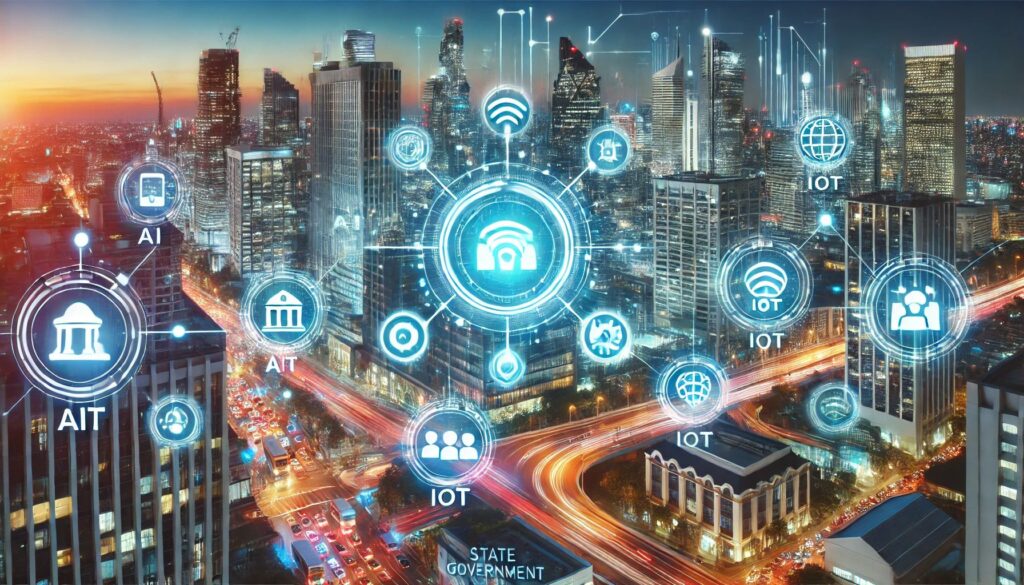
Table of Contents
In today’s fast-paced digital era, mobile apps state technology is transforming how state governments engage with citizens, deliver services, and enhance governance. The demand for efficiency, transparency, and accessibility has made mobile applications an essential tool in modern government operations.
From paying taxes to reporting infrastructure issues, mobile apps have made government services more user-friendly and accessible. This blog explores the role, key features, benefits, challenges, and future trends of mobile apps in state government technology solutions, backed by real-world examples, expert insights, and the latest industry trends.
Role of Mobile Apps in State Government Technology
Mobile Apps Bridge the Gap Between Citizens and Government Services
State government mobile apps act as a direct communication channel between citizens and public institutions, offering convenience, real-time updates, and improved service delivery.
Key benefits include:
✔ Instant Access to Government Services – Citizens can complete tasks like renewing licenses, paying utility bills, and registering complaints through their smartphones.
✔ Enhanced Communication – Push notifications alert residents about emergencies, policy changes, and community events.
✔ User Feedback & Engagement – Features like surveys and complaint tracking promote transparency and responsiveness.
For example, the California DMV app allows residents to schedule appointments, check wait times, and even renew driver’s licenses online, reducing long lines at service centers.
Benefits of Digital Transformation in State Governance
The shift to mobile solutions has led to:
✔ Cost Savings: Digital services reduce paperwork and administrative costs.
✔ Faster Service Delivery: Automation speeds up processing times for government applications and inquiries.
✔ Increased Citizen Satisfaction: Easy-to-use apps improve public trust and engagement.
According to a 2024 NASCIO (National Association of State Chief Information Officers) report, 85% of states prioritize digital transformation to enhance service efficiency.
Key Features of Mobile Apps for State Government Technology Solutions
User-Friendly Interfaces for Citizens
A seamless user experience ensures that government apps remain accessible to a diverse population, including elderly and disabled users.
🔹 Simple Navigation: Clear menus and intuitive layouts help users find services easily.
🔹 Accessibility Features: Voice commands, screen readers, and high-contrast modes for visually impaired users.
🔹 Multilingual Support: Language options ensure inclusivity for diverse communities.
Real-Time Access to Government Information
Timely information is essential for an informed citizenry. Key features include:
🔹 Live Notifications: Updates on emergencies, road closures, and policy changes.
🔹 Interactive Dashboards: Real-time statistics on public services, healthcare updates, and civic data.
🔹 Searchable Knowledge Bases: FAQs, laws, and resources for self-service access.
Secure and Transparent Payment Gateways
Many government apps include payment services for taxes, fines, and permits. Ensuring security and trust is crucial.
🔹 End-to-End Encryption: Protects personal and financial data.
🔹 Multi-Factor Authentication (MFA): Adds extra security layers to prevent fraud.
🔹 Transparent Fee Structures: Clear breakdowns of charges and digital receipts.
Tracking and Reporting Functionalities
Government apps enhance accountability with tracking features:
🔹 Service Request Tracking: Citizens can monitor progress on issues like pothole repairs or permit approvals.
🔹 GPS & AI Integration: Enables real-time issue reporting with geotagging.
🔹 Performance Analytics: Helps officials allocate resources based on demand trends.
Examples of State Government Mobile Apps
Successful Apps in Transportation
Many states have launched real-time transit apps that improve commuting experiences.
🚆 New York MTA App: Offers real-time train and bus tracking, ticket purchases, and alerts.
🚗 California Highway Patrol App: Allows users to report road hazards and accidents.
Health Sector Innovations
📲 CDC’s V-safe App: Provides COVID-19 vaccine tracking and adverse effect reporting.
📲 Florida’s Emergency Health Alert System: Sends real-time public health notifications.
Advancements in Education
🎓 Texas Education Agency’s Mobile Portal: Gives parents access to student grades, attendance, and assignments.
🎓 Illinois Virtual Learning App: Enables remote learning access for students across the state.
Case Studies Showcasing Innovation in Mobile Technology
📌 Georgia’s Smart City Initiative: Implemented a mobile app for reporting city maintenance issues, reducing service response times by 40%.
📌 Virginia’s Digital DMV Expansion: A mobile app overhaul led to a 30% reduction in in-person DMV visits within a year.
Benefits of Mobile Apps in State Governance
Citizen-Centric Benefits
✔ 24/7 Service Access: No need to visit government offices for basic services.
✔ Reduced Bureaucracy: Automation eliminates unnecessary paperwork.
✔ Faster Response Times: AI-powered chatbots and automated systems enhance efficiency.
Administrative Advantages
✔ Operational Cost Savings: Less reliance on physical infrastructure and manual processing.
✔ Data-Driven Decision-Making: AI analytics help governments improve service efficiency.
✔ Better Resource Allocation: Predictive analytics optimize service delivery.
Challenges in Implementing Mobile Apps for State Government Technology Solutions
Technical Challenges in Mobile Apps for State Government Technology Solutions
🔸 Legacy System Integration: Many states still use outdated IT infrastructure.
🔸 Cybersecurity Risks: Government apps are prime targets for cyber threats.
🔸 Data Scalability Issues: Growing user bases require robust backend solutions.
Social Challenges in Mobile Apps for State Government Technology Solutions
🔹 Digital Divide: Rural areas may lack internet access, limiting app adoption.
🔹 Privacy Concerns: Citizens may hesitate to share personal data with government entities.
🔹 User Adoption Barriers: Older adults may struggle with navigating mobile technology.
Future of Mobile Apps in State Government Technology
Emerging Trends Like AI in Mobile Apps for State Government Technology Solutions
🤖 AI Chatbots: Automating FAQs and support queries.
📊 Predictive Analytics: Helping governments allocate resources efficiently.
🔍 Facial Recognition & Biometric Authentication: Enhancing security for identity verification.
IoT Enhancements in Mobile Apps for State Government Technology Solutions
🌍 Smart Sensors: Monitor traffic, pollution, and public utilities in real time.
🚦 Connected Traffic Management: Reduces congestion with AI-driven signals.
Blockchain’s Role in Mobile Apps for State Government Technology Solutions
🔐 Secure Identity Verification: Prevents fraud and ensures transparency.
📜 Tamper-Proof Records: Protects land registries and legal documents.
Vision for Smart Governance Through Mobile Apps for State Government Technology Solutions
✔ Seamless Government-Citizen Interaction: AI-powered chatbots provide instant support.
✔ Efficient Emergency Response: IoT-driven disaster management alerts.
✔ Digital-Only Government Services: Reducing physical interactions for efficiency.
How Do Mobile Apps Improve State Government Technology?
Mobile apps improve state government technology by:
✔ Enhancing accessibility to services.
✔ Reducing costs through automation.
✔ Increasing citizen engagement and transparency.
What Features Are Essential in State Government Mobile Apps?
Essential features include:
✔ Secure Payments & Transactions
✔ Real-Time Notifications & Alerts
✔ User-Friendly UI/UX
✔ AI Chatbots & Predictive Analytics
What Challenges Do State Governments Face in Adopting Mobile Apps?
The biggest challenges include:
✔ Cybersecurity Threats
✔ Digital Divide & Accessibility
✔ Legacy System Compatibility
✔ User Trust & Privacy Concerns
Are Mobile Apps the Future of State Government Technology?
Yes! Mobile apps are key to modernizing state governance, offering:
✔ Faster service delivery
✔ Greater transparency
✔ AI-driven automation
With continued innovation, mobile apps will play a critical role in shaping the future of smart governance.
Can Citizens Trust Mobile Apps for Government Services?
Yes! With robust security measures, transparency, and ongoing updates, state government apps are safer and more reliable than ever. Governments must prioritize data privacy, encryption, and user education to maintain trust.
Conclusion
State governments are embracing mobile apps state technology to improve public service delivery, reduce costs, and enhance citizen engagement. With AI, IoT, and blockchain innovations, the future of digital governance looks promising.
Governments that invest in mobile solutions today will be better equipped to meet the evolving needs of their citizens tomorrow. 🚀

Pingback: Mobile Apps Revolutionizing State Government Technology - sharpsightpro.com